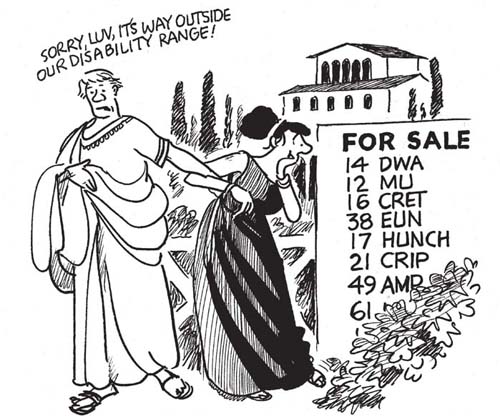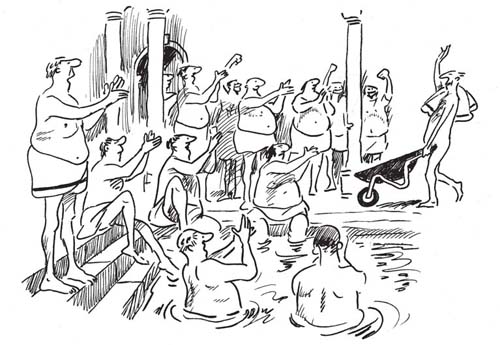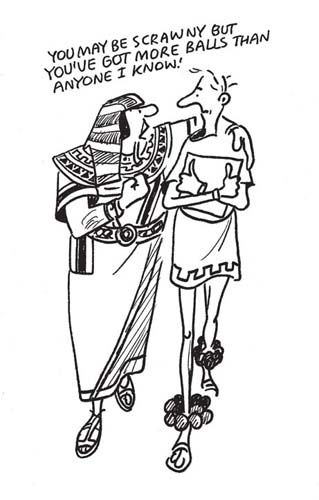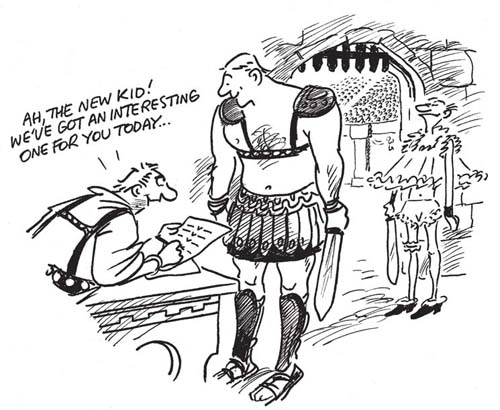Disgraceful Archaeology (10 page)
Read Disgraceful Archaeology Online
Authors: Paul Bahn

Torture: The ancient Chinese had a curious and horrible form of punishment. Some criminals were enclosed in barrels or boxes filled with building lime, and exposed in a public street to the rays of the noonday sun; food in plenty was within reach of the unfortunate wretches, but it was salt fish, or other salty foods, with all the water needed to satisfy the thirst this food was certain to excite, but in the very alleviation of which the poor criminals were only adding to the torments that would overtake them when by a more copious discharge from the kidneys the lime would ‘quicken’ and burn them to death.
The deformed and disabled in the Graeco-Roman world were regarded as outsiders, made (according to Pliny, the first century AD naturalist) by Nature to amuse herself and create wonder in us. Some turned it to their advantage — in fact, major employment opportunities awaited those willing to perform at parties or in the theatre. Some were credited with magic powers (a large penis was a useful qualification — it was thought to attract the gaze of the Evil Eye away from an intended victim). Others might be ‘lucky’ enough to be collected by an emperor, a very popular hobby.
Aristocratic Roman names commonly denoted disability — Flaccus (Big ears), Naso (Big nose), Crassus (Fatso), Strabo (Cross-eyed), and Peditus (possibly Farter).
Cicero tells of a midget witness whom Lucius Philippus asked permission to question. ‘Be short’ said the judge; ‘I’ll be as short as the witness’ quipped Lucius.
At moments of crisis the ugly and deformed, like other marginal groups, often become subject to physical persecution which may result in their death. For example, in ancient Greek society they selected a victim known as a ‘
pharmakos
’ or ‘scapegoat’, upon whom the blame for any evils afflicting the community was laid. The victim, who was often but not invariably ugly and deformed, underwent a ritual expulsion or, far less often, execution. They chose the ugly or deformed because these people were believed to harbour a grudge against Nature or the gods for making them freaks, as well as against society as a whole for denying them their full human status.
One account, based on the sixth-century BC poems of Hipponax, tells:
The
pharmakos
was in ancient times the expiatory offering as follows. If a misfortune afflicted a city as the result of divine wrath, whether famine or plague or some other catastrophe, they led out the ugliest person of all for sacrifice, to be the expiation and
pharmakos
of the suffering city. When they had arranged for the sacrifice to take place at a suitable spot, they placed cheese, barley meal and dried figs in the hands of the victim. After beating the victim seven times on the penis with squills [onion bulbs] and branches of wild fig and other wild trees, they finally set light to him on a fire consisting of wild branches. Then they cast his ashes to the winds and to the sea, so that this should be an expiation for the suffering city.
Deformed slaves are often mentioned in Latin literature — they were very popular. In fact it seems no fashionable household was complete without a generous sprinkling of dwarfs, mutes, cretins, eunuchs and hunchbacks, whose chief duty seems to have been to undergo degrading and painful humiliation in order to provide amusement at dinner parties and other festive occasions (
47
). The pretentious Zoilus, ridiculed by Martial, was attended by a catamite who supplied him with red feathers to assist him to vomit, as well as by a eunuch who steadied his wavering penis over a chamber pot while he was urinating..…
In one of Martial’s epigrams, a guest observes how an adulterous pair use a cretinous slave to pass lascivious kisses slyly back and forth by proxy, under the eyes of the woman’s unsuspecting husband:
Labulla has discovered how to kiss her lover in the presence of her husband. She constantly slobbers over her diminutive cretin. The lover then straightaway grabs hold of him dripping with kisses, and, having filled him up with his own, returns the cretin to his
smiling mistress. How much bigger an imbecile than the cretin is the husband!

47
Some Romans were actually prepared to pay more for deformed slaves than for physically perfect ones .… another of Martial’s epigrams has the speaker claiming that he paid a vast sum for a slave advertised by the dealer as being an idiot, and now demanding his money back because the slave is anything but a fool!
Plutarch says that, in Rome, the demand for freaks was so great that, in addition to the conventional markets where one could purchase run-of-the-mill handsome boys and beautiful girls, there also existed a ‘monster market’ .…
Pliny even tells of a dealer called Toranius Flaccus who managed to palm off two exceptionally handsome look-alike slaves as twins for 200,000 sesterces in spite of the fact that they came
from different parts of the empire and therefore spoke different dialects. When the fraud was exposed, the shrewd Toranius replied that this was precisely why he had charged so much — because, although there was nothing remarkable about fraternal twins looking alike, ‘to find such similarity in persons who belonged to different races was something that was beyond price.’
The fad for dwarfs sees to have originated in Pharaonic Egypt where confidential positions were assigned to ugly dwarfs, and the practice became widespread at the court of the Ptolemies, from where it travelled to Rome. According to Aelius Lampridus, the emperor Commodus favoured a certain individual ‘whose penis was larger than that of most animals’, on whom he ostentatiously bestowed the title of Onos or Donkey in deference to his majestic member. Moreover, at a dinner party he once exhibited two misshapen hunchbacks, who had been smeared in mustard, on a silver platter .…
Phenomenally large penises were in great demand in the Roman world a certain Hostius Quadra, described by Seneca as a
monstrum
, used to cruise round the public baths looking for the man with the largest sexual organ. A glutton for excess, Hostius then underwent sodomy in a room with enlarging mirrors ‘in order to take pleasure in the false size of his partner’s member by pretending that it was really that big.’ It seems the proud possessor of an outsized organ was treated with some respect, as in Martial’s epigram: ‘If from the baths you hear a round of applause, Maron’s giant prick is bound to be the cause.’ (
48
)
The emperor Elagabalus (AD 204–22) is even said to have rounded up all those who were endowed with an unusually large sexual organ, presumably for no loftier scientific purpose than that of comparing their respective lengths .… on another occasion he ordered all hernia sufferers to be brought to his baths so that he could have the perverse pleasure of bathing in their company.
Elagabalus possessed so many living deformities that his successor, Alexander Severus, was obliged to dispose of the entire collection, including the palace dwarfs, fearful that their
maintenance would exhaust his treasury. ‘Male and female dwarfs, imbeciles, and catamites, and all the entertainers and mimes Alexander gave to the public.…’

48
The Roman emperor himself was also often regarded as a monster or prodigy of a kind — this belief that the behaviour of extraordinary individuals can be accounted for in terms of some physical aberration is certainly still with us, as in the case of the entertaining theory that Adolf Hitler only had one ball, as alleged in a popular British wartime song.
Pliny compiled a catalogue of human oddity — about the tallest giants, the shortest dwarfs, record reproductivity, record longevity, etc. He says King Masinissa of Numidia (third century BC) became a father when he was over 86 years old .… Julius Caesar could simultaneously dictate four different letters to four different secretaries.
Aristotle tells us that the largest number of offspring ever produced at a single delivery was five — a feat achieved by one woman on no fewer than four occasions. In a catalogue of
persons of exceptional emaciation, the third-century AD Greek writer Athenaios claims that the poet and grammarian Philetas of Kos, tutor to an Egyptian king, was so thin that he had to wear leaden balls on his feet to prevent the wind from blowing him away (
49
). Capitolinus, a Roman historian of the fourth century AD, reports that the Emperor Maximinus, who is said to have been 8 Qw ft tall, was so strong that ‘he could drag wagons with his hands, shift a laden cart unassisted, knock out a horse’s teeth with his fist, or break its legs with his heel, crumble tufa, and split saplings. His thumb was so big that he used his wife’s bracelet for a ring. His predecessor Elagabulus once mocked him, saying ‘You are said to have tired sixteen, twenty, even thirty soldiers at a time. Can you perform thirty times with a woman?’

49
The record for intercourse with the greatest number of partners over a twenty-four hour period was held by Claudius’
wife Messalina, whose total of 25, sarcastically described by Pliny as a ‘royal triumph’, beat the record of the reigning champion, a notorious prostitute (
50
).

50
For Roman shows and games, dwarfs often paraded, dressed in extravagant costumes, many with huge, brightly coloured phalli strapped to their loins. They ran about tumbling, doing handstands, and performing simple acrobatic tricks. Sometimes there was a fight between women and dwarfs — as Statius (the first-century AD Roman poet) wrote, ‘It was enough to make Mars and the Goddess of Bravery split their sides laughing to see them hacking each other.’
The Brooklyn Museum has a famous limestone piece from Ptolemaic Egypt (late fourth century BC), officially called a ‘Symplegma’ or group of intertwined figures, but nicknamed ‘Snow White and the seven dwarfs’. The main figure is a large naked white woman in a curled wig. Around her are a number of smaller red-coloured men with enormous phalluses; she is seated on one phallus, while a second is penetrating her from the front!

